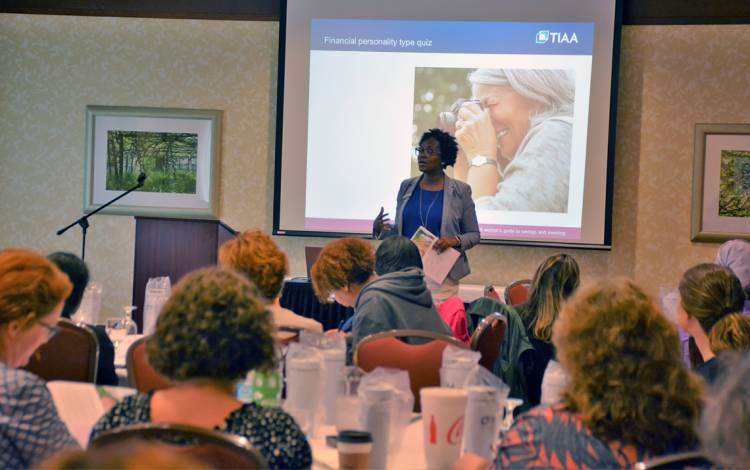6 Takeaways from Duke Financial Fitness Week
Financial planners share tips on how to cut debt, budget and save

Rick Teta is a planner.
That’s why the 47-year-old Duke maintenance specialist has been planning for retirement since his 20s and why he attended Duke Financial Fitness Week. He currently contributes 5 percent of his bi-monthly pay to a retirement account with Fidelity, but his goal is to increase that to 10 percent in the coming years.
“I would love to retire and be able to travel,” said Teta, who has worked for Duke 15 years.
During Financial Fitness Week 2017, which ran May 22-25, approximately 1,000 staff and faculty and their family members attended free workshops covering topics such as identifying and prioritizing savings goals, understanding Social Security in retirement and strategies for reducing debt.
Here are six takeaways from this year’s week:
Understanding good and bad debt
Any sound financial plan must address debt. As Fidelity’s Cary Bushman explained in “Create a Budget, Ditch Your Debt and Start Saving for the Future” webinar, all debt is not created equal.
Understanding differences between good and bad debt can help address it in a smart and efficient way.
The mortgage on a house – which in most cases will increase in value – is good debt. Student loans are also considered acceptable debt. Provided that interest rates are low, mortgage debt and student loans, which in some cases can have tax advantages, can be paid off over time.
Debt from auto loans – cars tend not to hold their value – and credit cards aren’t viewed as favorably.
After putting away money for savings, paying off high-interest credit cards should be a high priority. After that, any private high-interest student loans and auto loans need to be addressed.
Set budget priorities
Make small changes in your current budget for big savings and prioritize, prioritize, prioritize.
Bob Crowley, financial planner with Fidelity, suggested setting goals around saving for big-ticket items such as a new home, college tuition and retirement. Once goals are determined, make budget changes to get more money to those goals.
“We all have a lot of financial challenges that pull us in a lot of different directions,” Crowley said. “There are things we can do today to make a meaningful change in our trajectory.”
Downsizing homes and cutting back on dining out are some ways to find more money for savings, he suggested.
Fidelity offers the following spending rule of thumb: no more than 50 percent of take-home pay to essential expenses, 15 percent of pretax income to retirement savings, and 5 percent of take-home pay to short-term savings.
Plan for the unexpected
Long-term care insurance (LTCi) is an overlooked protection that can save you from unexpected costs.
LTCi typically pays for aide—at home, in assisted living or nursing homes – with everyday activities such as bathing and dressing over extended period of time for people impaired by illness, injury or old age, said Brad Winnekins, president of Legacy Services, a Wisconsin-based long-term care insurance broker.
Often, people who purchase LTCi have watched friends and family struggle to meet long-term care costs, Winnekins said during “Is Long-Term Care Insurance Right for Me?” seminar. The average LTCi purchaser’s age is 53 and Winnekins said that “70 percent of people who buy LTCi will lose money, 20 percent will break even, and 10 percent will get back way, way more than they paid in.”
Those odds aren’t for everybody.
However, with home health costs averaging $31,200 a year, assisted living $43,500 and nursing homes $82,100, some people are willing to take the odds, Winnekins said.
Duke no longer provides a group long-term care insurance plan but offers resources to help you assess options for coverage.
It’s never too early
The most important advice in the “Millenials: Ditch the Debt and Start Saving” seminar is likely familiar to every young career person.
For younger generation employees, time is on your side, so take advantage of it and start saving now.
As Fidelity financial advisor Alan Collins pointed out, age-specific investment funds calibrate risk based on target dates for retirement. With more time to grow, funds for younger investors can afford to be more aggressive.
With a Roth IRA, contributions are taxed on the way in, so when it comes time to retire, there’s no sting when you take money out. Over time, that seemingly small difference can loom large.
“I know a lot of employees have not yet enrolled and haven’t started saving,” Collins said. “But just having that conversation and sitting down and having that appointment is such a huge weight off their shoulders. You’re getting it going.”

It doesn’t hurt to ask
During “The Starting Line: Beginning to Save For Retirement” presentation, Shanna Crumpler, a financial consultant for TIAA, told her audience that, second only to putting away savings for retirement and emergencies, paying off credit cards should be a priority.
For customers who stay on track with payments, credit card companies often raise borrowers’ credit limits, sometimes without the cardholder even asking.
But what about getting credit card companies to lower your interest rate?
“Call them up,” Crumpler said. “Tell them ‘I’ve been with you for X number of years, I’ve paid every month on time. I know I’m a good customer because you keep giving me credit line increases. Can you reduce my interest rate?’”
This plan doesn’t always work, Crumpler said, but if you’ve been a valued customer, the company won’t want to lose you and might just give you a break.
Make a plan that fits your style
On average women live longer than men, but women have a shorter time to save money due to time away from work as caretakers – all the more reason for women to be smart, empowered investors, said TIAA’s Shanna Crumpler.
Crumpler presented “She’s Got It: A Woman’s Guide to Saving and Investing” and outlined challenges specific to females during financial planning, as well as tools to combat them such as more aggressive investing and using Duke’s employee financial resources.
One tip: Tailor your investing style to your financial personality. Crumpler identified four financial personality types: doers, learners, providers and planners. Each personality type confronts specific challenges. Doers should use less credit and prioritize savings. Learners struggle with financial organization and benefit from creating budgets. Providers take care of everybody else and should remember to invest in their own savings. Planners should take more risks and diversify their portfolios with different investment tools like Certificate of Deposits and money market funds.
Visit TIAA’s Woman2Woman, an online financial community that offers peer-to-peer and expert insights. Women can connect, ask questions and get valuable information about finances.